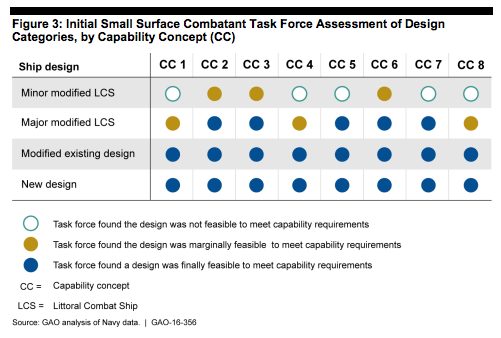The U.S. Navy is moving forward with a frigate version of the Littoral Combat Ship (LCS), but a new Government Accountability Office (GAO) report argues that the frigate version will provide neither needed capabilities nor the expected cost savings. The GAO is not alone in its concerns. Senator McCain, the chairman of the Senate Armed Services Committee, stated that it is “not clear what operational requirements the upgraded LCS is designed to meet.” The main issue with the LCS frigate seems to be that, in an effort to increase the number of ships without prohibitive costs, the Navy may wind up with a ship stuck balancing between presence missions and warfighting. As this was the issue with the original LCS, it is unclear how the frigate improves on its predecessor.
The GAO’s report highlights the problem with the LCS that the frigate is supposed to solve. Originally designed as a self-sufficient small combatant, the LCS saw its purpose change as the realization grew that it was “less capable of operating independently in higher threat environments than expected.” In 2014, then-Secretary of Defense Hagel capped the number of LCSs the Navy could buy due to his reservations about the ships. The LCS’s role in the Navy was shifted to one of providing presence, something that some military experts argue is vital for deterrence. At the same time, then-Secretary Hagel directed the Navy to develop solutions to these capability gaps. Later in 2014 year, the Navy recommended a “minorly-modified” frigate version of the LCS as a solution.
But, according to the task force set up to recommend solutions to the capability caps, the minorly-modified LCS frigate does not measure up. The graph below comes from the GAO report and shows that of all the options, the minorly-modified LCS meets the fewest capability concept requirements (and it is only ‘marginally feasible’ in the ones it does meet).
In particular, the inability of the modified LCS frigate to provide full multi-mission anti-submarine capabilities is troubling as the Navy highlighted anti-submarine warfare as the raison d’etre for developing the LCS frigate. The LCS frigate will also lack improvements to the original LCS’s anti-air capability, even as frigates are often tasked with defending high-value targets against air attacks. While the LCS frigate will carry an over-the-horizon missile, its other major capabilities will not be improved beyond what the original LCS carries.
Not only did the GAO pan the modified LCS on capabilities, it also raised concerns that the frigate version would cost more than estimated. In the Navy’s decision, cost was a major factor, and the minorly-modified LCS had the lowest lifecycle costs.
However, the GAO argued that assumptions made in the Navy’s cost analysis may have underestimated the minorly-modified LCS costs against other options. In particular, the Navy assumed significantly larger crews for other options than it did for the minorly-modified LCS. While this does not mean that costs of the LCS frigate will be much higher than expected, it does mean that the Navy may have opted for its least capable options under false assumptions.
Without further developments, then, it seems likely that the LCS frigate will suffer capability gaps similar to the original LCS. This raises the question of whether the new frigate will also slip into a ‘presence’ posture, used to show that the U.S. is engaged in areas of the world without the capability to fully defend itself. That is the counter-argument to the GAO’s critiques: that the Navy just needs more cheap ships to cover a wide-range of deployments. But that would defeat the purpose of the modifications, as that is a mission the original LCS could manage. What is the point of a somewhat upgraded LCS if it will only serve as a placeholder for more capable assets? Or, equally, if the frigate is to provide critical warfighting capability, why skimp on the upgrades for the sake of more ships?
It is likely that the Navy will have to further upgrade and develop these LCS frigates to get them to required standards, which will push back timelines and cause cost growth. It is certainly admirable that the Navy is trying to acquire ships with a mindset of thriftiness. Thriftiness for thriftiness’ sake, however, will return neither the needed capabilities nor the cost savings expected.

